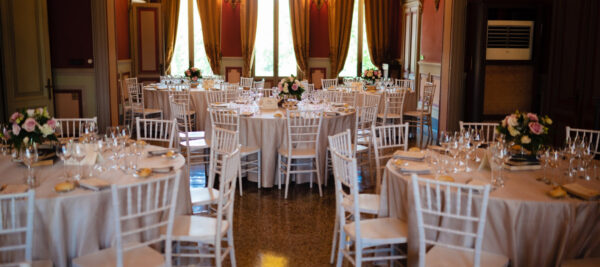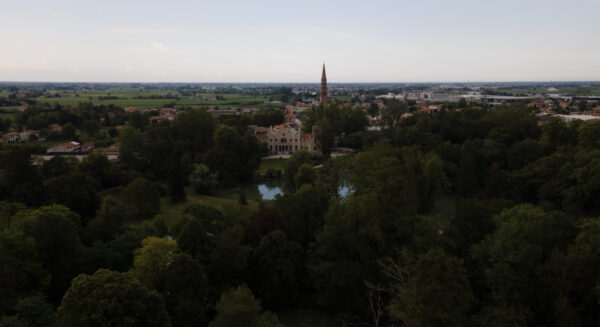Neo-Gothic and Romanticism in a Venetian Villa
“It was he (Spiridione Papadopoli) who, where once was the ancient castle, then the residence of the Counts of Tolentino, and later the first palace of the Gabrieli, built what is now a magnificent construction, almost a castle of the Middle Ages, that adds modern prestige and splendour to the ancient reputation of the land of San Polo.”
Luigi Dall’Oste, 1865
The villa
The main façade faces the lake and the Historic Park. It cannot be seen from the street: it is a place to be discovered and experienced without haste but with curiosity and wonder.
The current appearance of the Villa, in English Neo-Gothic style, dates back to 1888. In that year, Nicolò Papadopoli decided to extend the old square-shaped castle by grafting two side wings and decorating it with features that perfectly reflect 19th-century taste. Various architectural elements distinguish it: from bow-windows to crenelated towers, from Tudor arches to gargoyles. The internal structure is a labyrinth of rooms and staircases, and the three furnished floors allow visitors to discover the site’s long history, which began in 1192.
The Historic Park
Unlike most Venetian villas, which we find immersed in Italian-style gardens, the castle’s 19th-century Neo-Gothic style is reminiscent of an English-style outdoor space. The Park of Papadopoli Giol Castle, in fact, does not feature any typical Italian elements (such as hedge mazes, geometric flower parterres, statues, etc.) but is a romantic landscaped park.
In 1850, Count Spiridione Papadopoli decided to commission the renovation of this garden. The project, initially entrusted to Giuseppe Jappelli, was probably not to the liking of the Papadopoli family and was assigned to Francesco Bagnara, renowned master scenographer of the La Fenice Theatre and teacher at the Accademia di Belle Arti in Venice. Bagnara created a park with a great scenic effect, skilfully manoeuvring the existing natural elements and introducing new ones, managing to render the place illusively larger and opening up its boundaries to encompass the surrounding landscape in the views. The aim is to accompany guests to multiple viewpoints and ever-changing perspectives, where they can feel like actors on stage and spectators at the same time, along an intimate and meditative path.
The absolute protagonist of the Historic Park is the large meandering lake on which the Villa is reflected, creating a picturesque dialogue between nature and architecture.
This is the largest body of water of all the Venetian Villas. Already existing from the outset, Bagnara enlarged it in 1850 together with the Park project: the land resulting from the extension work led to the creation of three hills, one of which later became home to the evocative (and still visitable) ice-house.
It is currently possible to cross it with the rowing boat made available to visitors, which not only provides an evocative experience, but also gives the opportunity to see the Castle and the Park from an exclusive vantage point, discovering the interior views between the two small islands.
Inside the Park, in full 19th-century Romantic style, majestic centuries-old trees can still be seen, in a play of combinations of native and exotic plants. The iconic specimens here are the imposing Cedar of Lebanon and the Ginko Biloba, both dating back to 1860 and the closest trees to the villa.
Housing dozens of species, Parco Giol is also a home for local wildlife. Not only a destination for migratory birds, but an ideal habitat for different species of fish, turtles, pheasants, squirrels, bats, hares, etc.
The park provides the opportunity to experience an idyllic 19th century landscape from the inside: walking along the paths and rowing through the small islands, one has the impression of being inside a natural oasis far from the cities.











